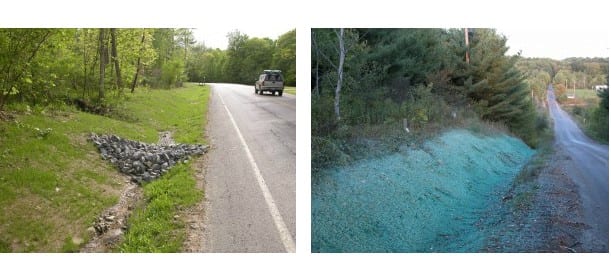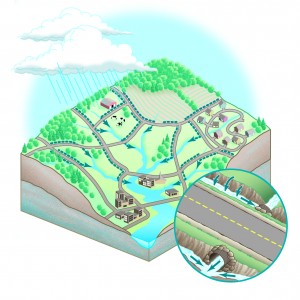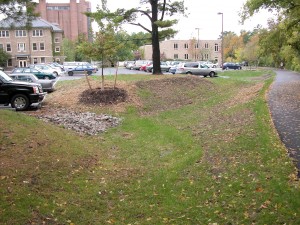Issue:
Roadside ditches are the shallow depressions which line
every road, efficiently draining stormwater, reducing road flooding, and enhancing road safety. Hundreds of miles of roadside ditches criss-cross each watershed. Coffin (2010) calculated that road densities average 1.42 km/ km2 across 89 countries globally, and in the contiguous US, 50% of land surface is within 382 meters of a road (Foreman 2000). However, the management practices for roadside ditches, instituted nationwide almost a century ago, have been implemented in large part without considering the impacts on downstream water resources. For example, scraping bottom substrates without revegetating leads to exposed sediment free to erode during storms.
______________
Researching Solutions:
Our team has been investigating the roles that roadside ditches are playing in floods, droughts, water pollution and stream health in New York. Our research thus far has documented that roadside ditch networks have the following impacts:
- Efficiently capture ~20% of the runoff in each watershed and shunt it rapidly to nearby streams where it is discharged, like a high-velocity faucet;
- Directly contribute to flooding in streams, increasing peak stream heights by as much as 300%;
- Act as major, rapid conduits of sediments, nutrients, fecal coliforms, and other pollutants from farm fields, lawns, parking lots and other land surfaces to streams;
- Are a major source of sediment when ditches are cleaned/scraped and left exposed to erosion during storms;
- Can transform contaminants, either acting as a filter or a contaminant source.
Our current research efforts are focused on the role of roadside ditches in transporting nitrogen from agricultural and suburban landscapes to streams, and the potential for ditch denitrification processes to contribute either as sources of greenhouse gas emissions of nitrous oxide, or as filters through complete denitrification.

______________
Extension to Improve Practices:
“Re-plumbing” our watersheds through improved management of roadside ditches can reduce many of the negative impacts. Comprehensive management of ditch networks throughout watersheds can also provide a valuable adaptive tool for buffering the extremes of climate change by reducing flooding in streams, maintaining higher water tables in aquifers that offset drought effects, and reducing water pollution that limits freshwater availability.
Management strategies fall into two broad groups:
- those strategies that disconnect the ditches from the streams and instead redirect the water to detention ponds, infiltrationbasins and other structures that encourage the water to infiltrate and recharge groundwater,
- practices which help to stabilize and filter out contaminants, reducing their transport to streams and downstream water supplies. Our fact sheet summarizes the available alternative strategies. Our team has given presentations to thousands of highway staff and local government officials and teamed up with the Cornell Local Roads Program to build better ditch management across NYS. In 2014, we also organized a conference on improving roadside ditch management for the entire Chesapeake Bay Watershed. In 2016, Chesapeake Bay Program has identified improved ditch management as a powerful tool for meeting its TMDL goals.
 LEFT Check dams slow erosive flows.
LEFT Check dams slow erosive flows.
RIGHT Hydroseeding is an efficient way to revegetate ditches after scraping and cleaning.
______________
Publications:
- McPhillips, L. E., P.M. Groffman, R.L.Schneider, and M. T.Walter. 2016. Nutrient cycling in grassed roadside ditches and lawns in a suburban watershed. Journal of Environmental Quality. In Press.
- Falbo, K., R.L.Schneider, D.H. Buckley, M.T.Walter, P.W. Bergholz, and B.P. Buchanan. 2013. Roadside ditches as conduits of fecal indicator organisms and sediment: implications for water quality management. Journal of Environmental Management 128: 1050-1059. http://dx.doi.org/10.1016/j.jenvman.2013.05.021
- Buchanan, B., Z.M. Easton, R.L. Schneider, and M.T. Walter. 2013. Modeling the hydrologic effects of roadside ditch networks on receiving waters. Journal of Hydrology 486: 293-305.
- Buchanan, B.P., K. Falbo, R.L.Schneider, Z.M. Easton, and M.T. Walter. 2012. Hydrologic impact of roadside ditches in an agricultural watershed in central New York: implications for non-point source pollutant transport. Hydrological Processes 27 (17): 2422-2437. DOI: 10.1002/hyp.9305
- Diaz-Robles, J. 2007. Evaluation of the effects of ditch management practices on suspended sediment, bedload and dissolved chemical contaminants transported to downstream receiving waters. M.S.Thesis. Dept. Civil and Environmental Engineering. 61 pp.
______________
Extension:
- Schneider R. and K. Boomer. Re-plumbing the Chesapeake Watershed: Roadside Ditch Management to Meet TMDL Water Quality Goals. 2016. Chesapeake Bay Program – Science and Technical Advisory Committee Publication 16-001. Edgewater, MD 43 pp. http://www.chesapeake.org/pubs/349_Boomer2016.pdf
- Schneider, R.L. Roadside Ditch Management Fact Sheet. RoadsideDitches fact sheet pdf
photos: R.Schneider illustration: J. Houghton



